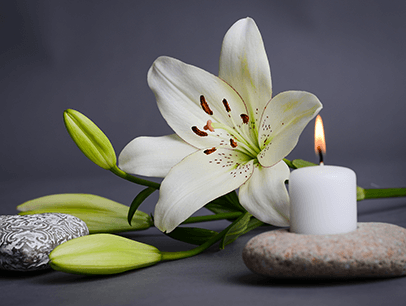
Being asked to write and/or deliver a eulogy can be one of the most rewarding yet difficult tasks you will face. Sometimes it’s an easy task, a labor of love, and the words flow; other times, it’s overwhelming, as emotions and memories flood the page. Often, it’s a combination of many thoughts.
A eulogy is an oral or written piece honoring a person’s life. As the presenter, you want people to walk away feeling better about the person, or wishing they knew them better. Often, the service may be the last or only time the person is publicly honored.
Writing a eulogy can be a daunting task. It helps to approach it like you would any good presentation, doing some homework and researching ahead of time. Four elements—purpose, structure, tone, and length—can help you put the thoughts together for a smoother flow and a more memorable experience for everyone listening.
Determine the Purpose of the Eulogy
Will you be the only one speaking about the person or will others as well? For example, an officiant may give statistical details (birth, family, background), and you may be asked to illuminate a more personal side of the person. Or you may be the only one giving the formal eulogy and need to include some background information in your presentation.
You’ll want to determine what role faith plays in your purpose. Some religions and churches have very strict rules about what the clergy can and cannot say, as well as who can deliver a eulogy if the service is conducted within the church. The family isn’t always aware of this aspect, so you might want to check with the clergy personally.
Writing and delivering a eulogy may be the hardest presentation you ever make.
Maybe you don’t know the person very well—perhaps you are the officiant, or the family asked you to deliver the eulogy because they know you are a good speaker. In that case, try to meet with a few key family members and friends and draw out their memories and stories. Questions might include: What are your favorite memories of this person? How did they impact your life and the lives of others? What did you admire about the person? You generally don’t need a lot of questions—just a few that will get the conversation started.
Find a Structure for Your Story
Like any good speech, a strong eulogy will benefit from a solid structure. Begin by brainstorming all that you could say about the person, then narrow it down to a few points and apply an appropriate structure, and even a theme if you feel it fits. You might find it easier to structure the speech by providing a timeline of the person’s life or by highlighting two to four life stories that have meaning to you and the audience.
Another consideration is what I call a “community to me” structure, one that is both far-reaching and very personal. I chose this structure for my dearest friend’s eulogy. As a professional speaker and instructor for over 30 years, I have delivered many presentations on a wide variety of topics, some lightweight and fun, and some very serious in nature. Easily the most difficult presentation I have made to date was the eulogy for my best friend for more than 50 years, Suzanne.
She asked me to present at her funeral, and of course I was honored and humbled, and also hopeful that the time really wouldn’t come, that a miracle would be performed, and the need would never arise. But that wasn’t the case. On one hand it was extremely difficult, yet on the other it was a true labor of love.
For Suzanne’s eulogy, I chose three points with a common theme of “Suzanne was love.” The first point encompassed the love she had for the community of people around her. Not necessarily her family and close friends but her involvement within her community, her church friends, and her coworkers, along with a related story.
The second point was the love she had for her family and friends, including her loving husband, children, and siblings, along with a related story. Finally, the most personal part was our relationship as best friends for over 50 years and why it was so easy to identify Suzanne as love, because that was the very core of her being, and I wanted to relay what her friendship meant to me over all those years.
I chose a couple of brief personal stories that touched on her love of laughter and some funny moments we shared. This type of structure also ensures that everyone in the audience is included while honoring and memorializing the person. You can speak in a conversational, heartfelt manner.
Set the Right Tone
To help settle on a tone, reflect on the following: Have you been asked to speak on behalf of the family? If so, what tone do they prefer? Some people want somber, some want joy and laughter, some want just the facts. Have you been asked to speak from a personal relationship with the person? If so, what was your relationship like and how does that direct the tone?
Did the person suffer through a long illness where there is now relief? Was it a sudden accident or suicide? Was the person young or old? While these are considerations, the eulogy focuses on how the person lived.
There is also the consideration of faith in the life and death of the person. For example, if the person was a Christian and the promise of heaven awaits them upon their death, the tone may be joyous. Other faiths have different beliefs about life after death. Maybe faith isn’t a consideration in the tone at all.
When appropriate, humor can play a major role in the tone of the entire eulogy. I recently delivered a eulogy for a woman who was 99 years old. She was more than ready to join her husband of 65 years who had preceded her in death. My friend loved to laugh, enjoyed life, and had a wonderful mischievous spirit that was contagious to everyone around her. While we were sad to see her pass, everyone in the room knew she was ready to go. Her eulogy was filled with funny stories. When her friends were asked to say a few words in memory of her, the theme of mischief and fun continued throughout the entire room. It was truly a celebration of her long life and her uncanny ability to befriend everyone she met.
Consider the Length
The suggested length for a stand-alone eulogy, one that doesn’t offer background information, is four to six minutes. However, if part of your role is to offer the factual obituary information, the speech may be slightly longer, but still not over 10 minutes. Remember, people aren’t there to hear you speak but to honor the person who died.
Remember, people aren’t there to hear you speak but to honor the person who died.
Writing and delivering a eulogy may be the hardest presentation you ever make. Unless you are a professional who delivers eulogies on a regular basis, you may only deliver one, two, or a few in your lifetime. Each eulogy should be as personal and unique as the person you are honoring. Taking into consideration the purpose, structure, tone, and length may help you write a better speech in respect of your loved one. Your heartfelt delivery will make this presentation special as you remember the person you honored.
Tammy A. Miller, DTM is a member of State College Toastmasters in State College, Pennsylvania. She is a Past International Director, and a Toastmasters Accredited Speaker, professional auctioneer, and speech coach. She is also the co-author of The Joyful Journey of Hospital Clowning and the author of The Lighter Side of Breast Cancer Recovery. Learn more at www.tammyspeaks.com.



 Previous
Previous
 Previous Article
Previous Article

